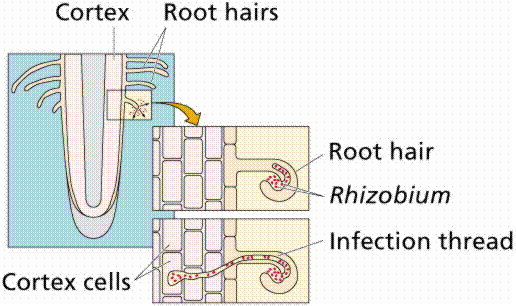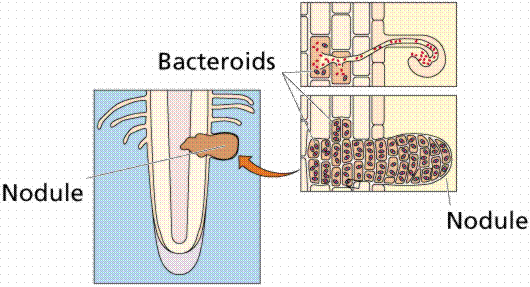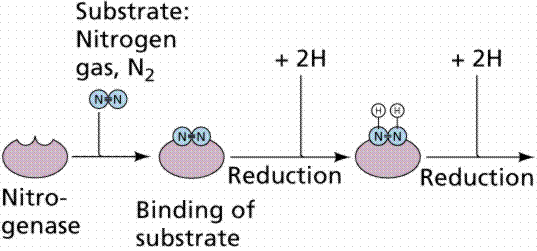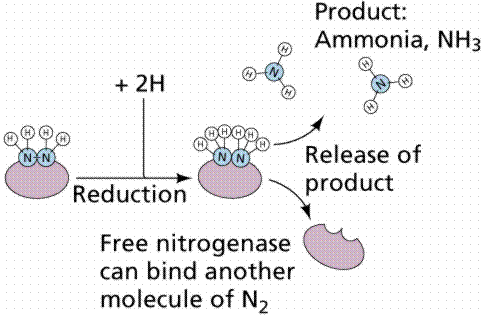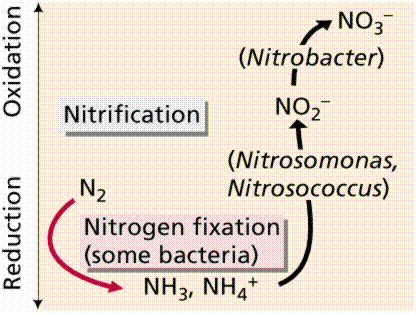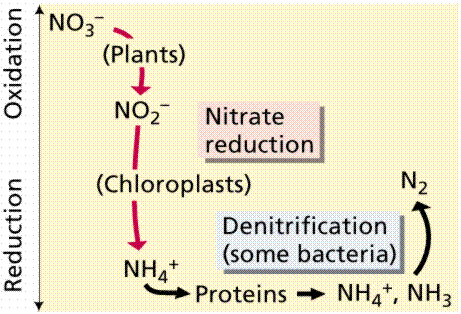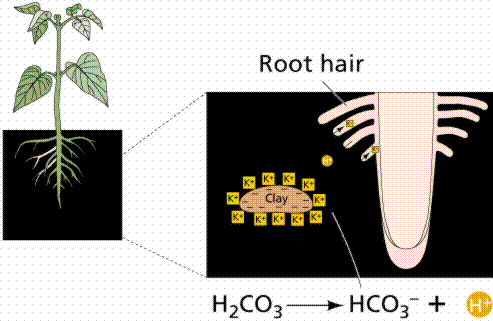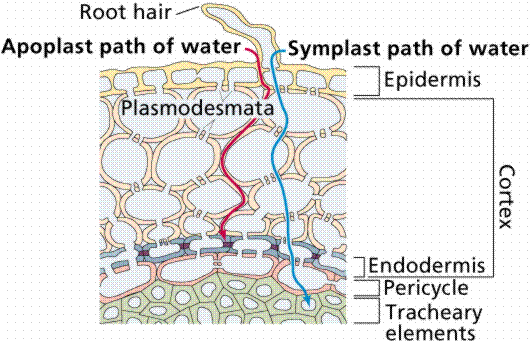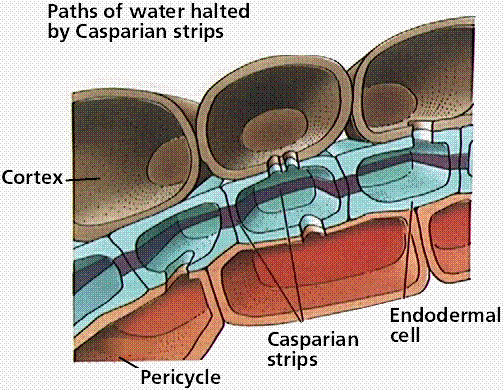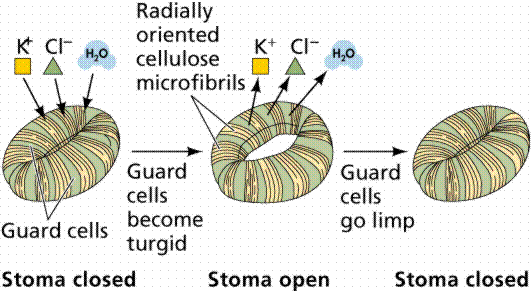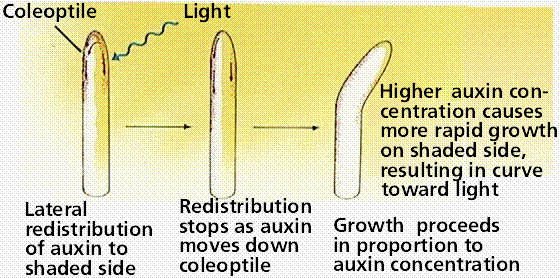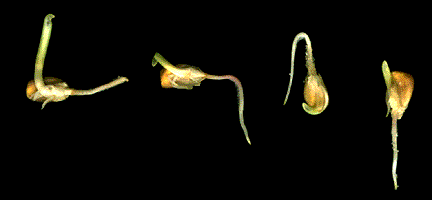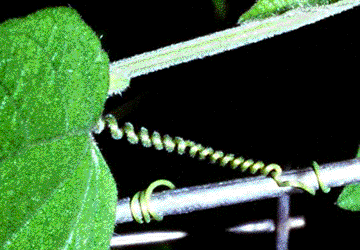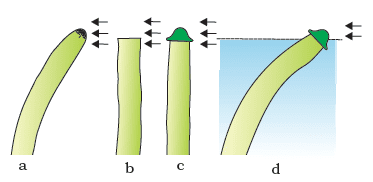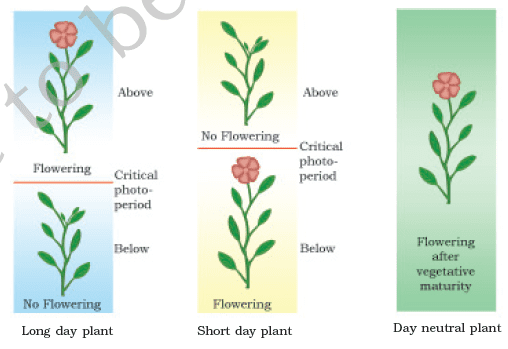clockworx
- 953
- 243
A hormone is any chemical produced in one part of the body that has a target elsewhere in the body. Plants have five classes of hormones. Animals, especially chordates, have a much larger number. Hormones andenzymes serve as control chemicals in multicellular organisms. One important aspect of this is the obtaining of food and/or nutrients
Auxins promote stem elongation, inhibit growth of lateral buds (maintains apical dominance). They are produced in the stem, buds, and root tips. Example: Indole Acetic Acid (IA). Auxin is a plant hormone produced in the stem tip that promotes cell elongation. Auxin moves to the darker side of the plant, causing the cells there to grow larger than corresponding cells on the lighter side of the plant. This produces a curving of the plant stem tip toward the light, a plant movement known as phototropism.
Auxin also plays a role in maintaining apical dominance. Most plants have lateral (sometimes called axillary) buds located at nodes (where leaves attach to the stem). Buds are embryonic meristems maintained in a dormant state. Auxin maintains this dormancy. As long as sufficient auxin is produced by the apical meristem, the lateral buds remain dormant. If the apex of the shoot is removed (by a browsing animal or a scientist), the auxin is no longer produced. This will cause the lateral buds to break their dormancy and begin to grow. In effect, the plant becomes bushier. When a gardener trims a hedge, they are applying apical dominance.
Gibberellins promote stem elongation. They are not produced in stem tip. Gibberellic acid was the first of this class of hormone to be discovered.
Cytokinins promote cell division. They are produced in growing areas, such as meristems at tip of the shoot. Zeatin is a hormone in this class, and occurs in corn (Zea ).
Abscisic Acid promotes seed dormancy by inhibiting cell growth. It is also involved in opening and closing of stomata as leaves wilt.
Ethylene is a gas produced by ripe fruits. Why does one bad apple spoil the whole bunch? Ethylene is used to ripen crops at the same time. Sprayed on a field it will cause all fruits to ripen at the same time so they can be harvested.
Unlike animals (which obrtain their food from what they eat) plants obtain their nutrition from the soil and atmosphere. Using sunlight as an energy source, plants are capable of making all the organic macromolecules they need by modifications of the sugars they form by photosynthesis. However, plants must take up variousminerals through their root systems for use.
A (plant) balanced diet
Carbon, Hydrogen, and Oxygen are considered the essential elements. Nitrogen, Potassium, and Phosphorous are obtained from the soil and are the primary macronutrients. Calcium, Magnesium, and Sulfur are thesecondary macronutrients needed in lesser quantity. The micronutrients, needed in very small quantities and toxic in large quantities, include Iron, Manganese, Copper, Zinc, Boron, and Chlorine. A complete fertilizer provides all three primary macronutrients and some of the secondary and micronutrients. The label of the fertilizer will list numbers, for example 5-10-5, which refer to the percent by weight of the primary macronutrients.
Auxins promote stem elongation, inhibit growth of lateral buds (maintains apical dominance). They are produced in the stem, buds, and root tips. Example: Indole Acetic Acid (IA). Auxin is a plant hormone produced in the stem tip that promotes cell elongation. Auxin moves to the darker side of the plant, causing the cells there to grow larger than corresponding cells on the lighter side of the plant. This produces a curving of the plant stem tip toward the light, a plant movement known as phototropism.
Auxin also plays a role in maintaining apical dominance. Most plants have lateral (sometimes called axillary) buds located at nodes (where leaves attach to the stem). Buds are embryonic meristems maintained in a dormant state. Auxin maintains this dormancy. As long as sufficient auxin is produced by the apical meristem, the lateral buds remain dormant. If the apex of the shoot is removed (by a browsing animal or a scientist), the auxin is no longer produced. This will cause the lateral buds to break their dormancy and begin to grow. In effect, the plant becomes bushier. When a gardener trims a hedge, they are applying apical dominance.
Gibberellins promote stem elongation. They are not produced in stem tip. Gibberellic acid was the first of this class of hormone to be discovered.
Cytokinins promote cell division. They are produced in growing areas, such as meristems at tip of the shoot. Zeatin is a hormone in this class, and occurs in corn (Zea ).
Abscisic Acid promotes seed dormancy by inhibiting cell growth. It is also involved in opening and closing of stomata as leaves wilt.
Ethylene is a gas produced by ripe fruits. Why does one bad apple spoil the whole bunch? Ethylene is used to ripen crops at the same time. Sprayed on a field it will cause all fruits to ripen at the same time so they can be harvested.
Unlike animals (which obrtain their food from what they eat) plants obtain their nutrition from the soil and atmosphere. Using sunlight as an energy source, plants are capable of making all the organic macromolecules they need by modifications of the sugars they form by photosynthesis. However, plants must take up variousminerals through their root systems for use.
A (plant) balanced diet
Carbon, Hydrogen, and Oxygen are considered the essential elements. Nitrogen, Potassium, and Phosphorous are obtained from the soil and are the primary macronutrients. Calcium, Magnesium, and Sulfur are thesecondary macronutrients needed in lesser quantity. The micronutrients, needed in very small quantities and toxic in large quantities, include Iron, Manganese, Copper, Zinc, Boron, and Chlorine. A complete fertilizer provides all three primary macronutrients and some of the secondary and micronutrients. The label of the fertilizer will list numbers, for example 5-10-5, which refer to the percent by weight of the primary macronutrients.
Soils play a role
Soil is weathered, decomposed rock and mineral (geological) fragments mixed with air and water. Fertile soil contains the nutrients in a readily available form that plants require for growth. The roots of the plant act as miners moving through the soil and bringing needed minerals into the plant roots.
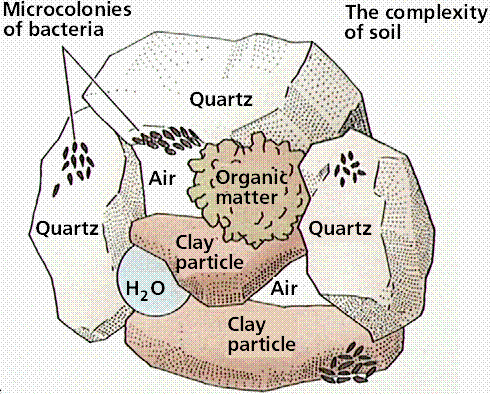
Plants use these minerals in:
Soil is weathered, decomposed rock and mineral (geological) fragments mixed with air and water. Fertile soil contains the nutrients in a readily available form that plants require for growth. The roots of the plant act as miners moving through the soil and bringing needed minerals into the plant roots.

Plants use these minerals in:
- Structural components in carbohydrates and proteins
- Organic molecules used in metabolism, such as the Magnesium in chlorophyll and the Phosphorous found in ATP
- Enzyme activators like potassium, which activates possibly fifty enzymes
- Maintaining osmotic balance
Last edited:

